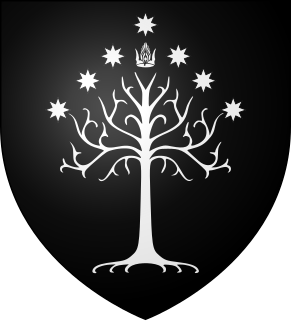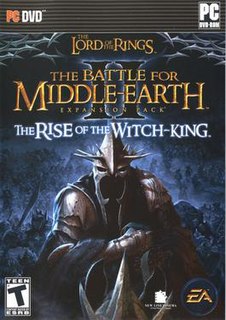This article is being considered for deletion in accordance with Wikipedia's deletion policy. Please share your thoughts on the matter at this article's entry on the Articles for deletion page. |
Arvedui is a fictional character from J. R. R. Tolkien's Middle-earth legendarium, who was the last King of Arnor before its destruction. [1]
Arvedui was the son of King Araphant of Arthedain. He was born in T.A. 1864 and came to the throne in 1964 at the death of his father. His name meant Last king, and he was named so because of a prophecy by Malbeth the Seer: [2]
Arvedui married Fíriel, daughter of King Ondoher of Gondor, in 1940. This was the first renewal of contact between Arnor (the northern kingdom) and Gondor (the southern one), after a long estrangement, when both realized that both kingdoms were coming under simultaneous attack from the regrouping forces of Sauron (Angmar against Arthedain, the Wainriders against Gondor). At Ondoher's death in 1944, Arvedui sent messages to Gondor claiming the throne as a direct descendant of Isildur and as the husband of Fíriel, the only surviving child of King Ondoher (since the King and both his sons perished in the battle against the Wainriders). Arvedui was refused by Pelendur the Steward of Gondor: the Gondorians appointed general Eärnil as King instead. [3]
Arvedui became King of Arthedain soon after, inheriting a shattered Kingdom that was struggling to hold back the assaults of Angmar. In T.A. 1974 Angmar made one final push against Arthedain, capturing the capital of Fornost and driving the surviving Dúnedain away. He and his guard hid in the old Dwarf mines of the northern Blue Mountains near the Ice-bay of Forochel. Gondor sent help in the form of a great fleet, but it was delayed and came too late: Arthedain was overrun and its people all perished almost to the last. Starvation drove Arvedui to seek the aid of the inhabitants of Forochel, the Lossoth snowmen. Though the inhabitants were initially reluctant to aid, they helped the gaunt King out of pity, and also out of fear of their weapons. [4]
Círdan of Lindon sent a ship north to rescue him in 1975, and against the advice of the Snowmen of Forochel, Arvedui boarded it. Before departing, he gave his ring, the Ring of Barahir, to the chief of the Snowmen. Shortly after leaving land, the ship was crushed by ice packs and the king drowned. In this shipwreck the palantíri of Amon Sûl and Annúminas were lost forever. Shortly afterwards, a Gondorian army under Eärnur managed to destroy Angmar with the help of Círdan, but Arthedain and all of Arnor were no more, and the kingship had ended.
His son Aranarth became the first of the Chieftains of the Dúnedain. [5] Despite the fall of the North Kingdom, the line of Isildur remained unbroken. Arvedui's claim was never forgotten by his descendants, though it would be centuries before Aragorn invoked the claim. [6]
It is commonly thought that the line of Anárion had ended, as Eärnil's son Eärnur had left no heir. However, it is worth noting that the line of Anárion did run in Arvedui's descendants, thanks to his marriage to Fíriel who was directly descended from Anárion.
The prophecy became truth, for Arvedui was indeed the last King of Arnor, and likewise the line of the Kings of Gondor also ended with Eärnil's son Eärnur. The realms were not reunited until a thousand years later, when Aragorn became King Elessar.
In The Lord of the Rings Online, Arvedui plays an important role in the Epic volume quests for Book 13: The Doom of the Last King. The ghost of Arvedui can be found at the wreck of the ship that was sent to rescue him in TA 1975 but was destroyed by ice, where he gives players several important quests that advance the games Epic Story-line plot.
In The Lord of the Rings: The Battle for Middle Earth II: The Rise of the Witch-king, Arvedui appears as a hero unit in the final evil campaign mission where he leads the defenders at the Battle of Fornost.
Games Workshop also produced a metal model of King Arvedui for The Lord of the Rings: Strategy Battle Game.

Gondor is a fictional kingdom in J. R. R. Tolkien's writings, described as the greatest realm of Men in the west of Middle-earth by the end of the Third Age. The third volume of The Lord of the Rings, The Return of the King, is largely concerned with the events in Gondor during the War of the Ring and with the restoration of the realm afterward. The history of the kingdom is outlined in the appendices of the book.
In J. R. R. Tolkien's Middle-earth fiction, such as The Hobbit and The Lord of the Rings, the terms Man and Men refer to humankind – in contrast to Elves, Dwarves, Orcs, and other humanoid races – and does not denote gender. Hobbits were a branch of the lineage of Men.
A palantír is a fictional magical artefact from J. R. R. Tolkien's Middle-earth legendarium. A palantír is described as a crystal ball, used for both communication and as a means of seeing events in other parts of the world or in the distant past or in the future.
Elendil is a fictional character in J. R. R. Tolkien's legendarium. He is mentioned in The Lord of the Rings, The Silmarillion and Unfinished Tales.

Arnor is a fictional kingdom in J. R. R. Tolkien's writings. Arnor, or the North-kingdom, was a realm of the Dúnedain in the region of Eriador in Middle Earth. Arnor was founded near the end of the Second Age (S.A. 3320) by Elendil, whose sons Isildur and Anárion founded Gondor at the same time. The history of the two kingdoms is intertwined; both kingdoms are known as the Realms of the Dúnedain in Exile.
Anárion is a fictional character in J. R. R. Tolkien's Middle-earth legendarium. His name is derived from Anar, which means "Sun" in Tolkien's invented language of Quenya. He was the son of Elendil and the brother of Isildur, and with them established the Realms in Exile in Middle-earth after the downfall of Númenor.

Angmar is a fictional kingdom in J. R. R. Tolkien's continent of Middle-earth, at the north end of the Misty Mountains. It was used by the Lord of the Ringwraiths as a base from which to attack the kingdoms of the Dúnedain in the North, all of which were eventually destroyed. Angmar itself was subsequently destroyed by combined armies of men and elves shortly thereafter.

Minas Morgul also known by its earlier name of Minas Ithil is a fictional fortified city in J. R. R. Tolkien's Middle-earth.
In J. R. R. Tolkien's Legendarium, the Battle of the Pelennor Fields [pɛˈlɛnnɔr] is the battle for the city of Minas Tirith between the forces of Gondor and its allies, and the forces of the Dark Lord Sauron. Tolkien recounts this battle in The Return of the King, the third volume of his 1954–55 novel The Lord of the Rings as originally printed. It is the largest battle and one of the most important events of the War of the Ring, the war in which the Third Age of Middle-earth comes to a close. It takes place on 15th 'March' T.A. 3019 in the Pelennor Fields, the townlands and fields between Minas Tirith and the River Anduin. The concept and history of composition of the battle is detailed in the fourth volume of The History of the Lord of the Rings.
In the fantasy writings of J. R. R. Tolkien, Weathertop is a hill in Eriador, a region of Middle-earth. It is the southernmost and highest summit of the Weather Hills. The hill itself is of great importance in the history of Middle-earth, as chronicled in The Lord of the Rings, since it was a major fortress of the kingdom of Arthedain, home to one of the seven palantíri, and the site of several battles.
In J. R. R. Tolkien's legendarium, the Rangers of the North, also known as the Dúnedain of the North, were the descendants of the Dúnedain from the lost kingdom of Arnor. They were Men, and one of the Free Peoples of Middle-earth. Their menfolk ceaselessly patrolled the boundaries of Eriador and were by necessity skilled with the sword, bow, and spear.
In J.R.R. Tolkien's Middle-earth, the High Kings of Arnor and Gondor were the Kings of all Dúnedain in Middle-earth after the Downfall of Númenor. Elendil was the leader of the Elendili who survived the Downfall. He claimed the title of High King.
J. R. R. Tolkien adopted the term Northmen in his fiction; his "Northmen" were Men that lived in northern Wilderland in Middle-earth, and were friendly to Gondor.

The Lord of the Rings: The Battle for Middle-earth II: The Rise of the Witch-king is a real-time strategy video game published by Electronic Arts, based on the Lord of the Rings film series based on the book, directed by Peter Jackson. The Rise of the Witch-king is the official expansion to The Lord of the Rings: The Battle for Middle-earth II, which was published by the same company and released in 2006, for Microsoft Windows. The Rise of the Witch-king was shipped to stores in the United States on November 28, 2006 and was officially released on November 30, 2006.
J. R. R. Tolkien's Middle-earth fantasy writings include many wars and battles set in the lands of Aman, Beleriand, Númenor, and Middle-earth. These are related in his various books such as The Hobbit and The Lord of the Rings, and The Silmarillion, Unfinished Tales and other posthumously published books edited by his son Christopher Tolkien.
In J. R. R. Tolkien's legendarium, the Dúnedain were a race of Men descended from the Númenóreans who survived the sinking of their island kingdom and came to Eriador in Middle-earth, led by Elendil and his sons, Isildur and Anárion. They are also called the Men of the West and the Men of Westernesse. They settled mainly in Arnor and Gondor.
The Witch-king of Angmar, also known as the Lord of the Nazgûl and the Black Captain, is a character in Tolkien's legendarium. In J. R. R. Tolkien's The Lord of the Rings, he is the chief of the Nazgûl or "Ringwraiths", the chief servants of the Dark Lord, Sauron. His name is not revealed in any of Tolkien's writings, nor are the names of any of the other Nazgûl except Khamûl.
Aragorn II, son of Arathorn is a fictional character from J. R. R. Tolkien's legendarium. He is one of the main protagonists of The Lord of the Rings. Aragorn was a Ranger of the North, first introduced with the name Strider at Bree, as the Hobbits continued to call him throughout The Lord of the Rings. He was eventually revealed to be the heir of Isildur and rightful claimant to the thrones of Arnor and Gondor. He was also a confidant of Gandalf and an integral part of the quest to destroy the One Ring and defeat the Dark Lord Sauron.
Elrond Half-elven is a fictional character in J. R. R. Tolkien's Middle-earth legendarium. He is introduced in The Hobbit, and plays a supporting role in The Lord of the Rings and The Silmarillion.